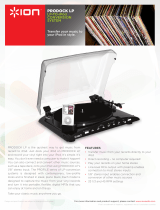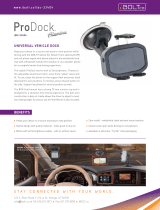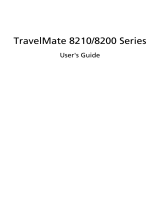Page is loading ...

Acer ProDock II
User Guide

Model number: __________________________________
Serial number: ___________________________________
Date of purchase: ________________________________
Place of purchase: ________________________________
© 2013 All Rights Reserved.
Acer ProDock II User Guide
This revision: 07/2013

3
English
Information for your safety and comfort
Safety instructions
Read these instructions carefully. Keep this document for future reference.
Follow all warnings and instructions marked on the product.
Turning the product off before cleaning
Unplug this product from the wall outlet before cleaning. Do not use liquid
cleaners or aerosol cleaners. Use a damp cloth for cleaning.
Warnings
Accessing the power cord
Be sure that the power outlet you plug the power cord into is easily
accessible and located as close to the equipment operator as possible.
When you need to disconnect power to the equipment, be sure to unplug
the power cord from the electrical outlet.
Disconnecting the power source
Observe the following guidelines when connecting and disconnecting
power to the power supply unit:
Install the power supply unit before connecting the power cord to the AC
power outlet.
If the system has multiple sources of power, disconnect power from the
system by unplugging all power cords from the power supplies.
Using electrical power
• This product should be operated from the type of power indicated on
the marking label. If you are not sure of the type of power available,
consult your dealer or local power company.
• Do not allow anything to rest on the power cord. Do not locate this
product where people will walk on the cord.
• If an extension cord is used with this product, make sure that the total
ampere rating of the equipment plugged into the extension cord does
not exceed the extension cord ampere rating. Also, make sure that the
total rating of all products plugged into the wall outlet does not exceed
the fuse rating.

4
English
• Do not overload a power outlet, strip or receptacle by plugging in too
many devices. The overall system load must not exceed 80% of the
branch circuit rating. If power strips are used, the load should not
exceed 80% of the power strip's input rating.
• This product's AC adapter is equipped with a three-wire grounded
plug. The plug only fits in a grounded power outlet. Make sure the
power outlet is properly grounded before inserting the AC adapter
plug. Do not insert the plug into a non-grounded power outlet. Contact
your electrician for details.
Warning! The grounding pin is a safety feature. Using a power
outlet that is not properly grounded may result in electric shock
and/or injury.
Note: The grounding pin also provides good protection from
unexpected noise produced by other nearby electrical devices that
may interfere with the performance of this product.
• The system can be powered using a wide range of voltages; 100 to
120 or 220 to 240 V AC. The power cord included with the system
meets the requirements for use in the country/region where the system
was purchased. Power cords for use in other countries/regions must
meet the requirements for that country/region. For more information on
power cord requirements, contact an authorized reseller or service
provider.
Protecting your hearing
Warning: Permanent hearing loss may occur if
earphones or headphones are used at high volume for
prolonged periods of time.
To protect your hearing, follow these instructions.
• Increase the volume gradually until you can hear clearly and
comfortably.
• Do not increase the volume level after your ears have adjusted.
• Do not listen to music at high volumes for extended periods.
• Do not increase the volume to block out noisy surroundings.
• Decrease the volume if you can't hear people speaking near you.

5
English
General
• Do not use this product near water.
• Do not place this product on an unstable cart, stand or table. If the
product falls, it could be seriously damaged.
• Slots and openings are provided for ventilation to ensure reliable
operation of the product and to protect it from overheating. These
openings must not be blocked or covered. The openings should never
be blocked by placing the product on a bed, sofa, rug or other similar
surface. This product should never be placed near or over a radiator or
heat register, or in a built-in installation unless proper ventilation is
provided.
• Never push objects of any kind into this product through cabinet slots
as they may touch dangerous voltage points or short-out parts that
could result in a fire or electric shock. Never spill liquid of any kind onto
or into the product.
• To avoid damage of internal components and to prevent battery
leakage, do not place the product on a vibrating surface.
• Never use it under sporting, exercising, or any vibrating environment
which will probably cause unexpected short current or damage rotor
devices, HDD, Optical drive, and even exposure risk from lithium
battery pack.
• The bottom surface, areas around ventilation openings and AC
adapter may get hot. To avoid injury, ensure they do not come in
contact with your skin or body.
• Your device and its enhancements may contain small parts. Keep
them out of the reach of small children.
Product servicing
Do not attempt to service this product yourself, as opening or removing
covers may expose you to dangerous voltage points or other risks. Refer all
servicing to qualified service personnel.
Unplug this product from the wall outlet and refer servicing to qualified
service personnel when:
• The power cord or plug is damaged, cut or frayed.
• Liquid was spilled into the product.
• The product was exposed to rain or water.
• The product has been dropped or the case has been damaged.
• The product exhibits a distinct change in performance, indicating a
need for service.
• The product does not operate normally after following the operating

6
English
instructions.
Note: Adjust only those controls that are covered by the operating
instructions, since improper adjustment of other controls may result in
damage and will often require extensive work by a qualified technician
to restore the product to normal condition.
Disposal instructions
Do not throw this electronic device into the trash when
discarding.
To minimize pollution and ensure utmost protection of the global
environment, please recycle. For more information on the Waste
from Electrical and Electronics Equipment (WEEE) regulations,
visit www.acer-group.com/public/Sustainability/sustainability01.htm
Tips and information for comfortable use
Computer users may complain of eyestrain and headaches after prolonged
use. Users are also at risk of physical injury after long hours of working in
front of a computer. Long work periods, bad posture, poor work habits,
stress, inadequate working conditions, personal health and other factors
greatly increase the risk of physical injury.
Incorrect computer usage may lead to carpal tunnel syndrome, tendonitis,
tenosynovitis or other musculoskeletal disorders. The following symptoms
may appear in the hands, wrists, arms, shoulders, neck or back:
• Numbness, or a burning or tingling sensation.
• Aching, soreness or tenderness.
• Pain, swelling or throbbing.
• Stiffness or tightness.
• Coldness or weakness.
If you have these symptoms, or any other recurring or persistent discomfort
and/or pain related to computer use, consult a physician immediately and
inform your company's health and safety department.
The following section provides tips for more comfortable computer use.

7
English
Finding your comfort zone
Find your comfort zone by adjusting the viewing angle of the monitor, using
a footrest, or raising your sitting height to achieve maximum comfort.
Observe the following tips:
• Refrain from staying too long in one fixed posture.
• Avoid slouching forward and/or leaning backward.
• Stand up and walk around regularly to remove the strain on your leg
muscles.
• Take short rests to relax your neck and shoulders.
• Avoid tensing your muscles or shrugging your shoulders.
• Install the external display, keyboard and mouse properly and within
comfortable reach.
• If you view your monitor more than your documents, place the display
at the center of your desk to minimize neck strain.
Taking care of your vision
Long viewing hours, wearing incorrect glasses or contact lenses, glare,
excessive room lighting, poorly focused screens, very small typefaces and
low-contrast displays could stress your eyes. The following sections
provide suggestions on how to reduce eyestrain.
Eyes
• Rest your eyes frequently.
• Give your eyes regular breaks by looking away from the monitor and
focusing on a distant point.
• Blink frequently to keep your eyes from drying out.
Display
• Keep your display clean.
• Keep your head at a higher level than the top edge of the display so
your eyes point downward when looking at the middle of the display.
• Adjust the display brightness and/or contrast to a comfortable level for
enhanced text readability and graphics clarity.
• Eliminate glare and reflections by:
• Placing your display in such a way that the side faces the window
or any light source.
• Minimizing room light by using drapes, shades or blinds.
• Using a task light.
• Changing the display's viewing angle.
• Using a glare-reduction filter.

8
English
• Using a display visor, such as a piece of cardboard extended from
the display's top front edge.
• Avoid adjusting your display to an awkward viewing angle.
• Avoid looking at bright light sources for extended periods of time.
Developing good work habits
The following work habits make computer use more relaxing and
productive:
• Take short breaks regularly and often.
• Perform some stretching exercises.
• Breathe fresh air as often as possible.
• Exercise regularly and maintain a healthy body.
Warning! We do not recommend using the computer on a couch
or bed. If this is unavoidable, work for only short periods, take
breaks regularly, and do some stretching exercises.
Note: For more information, please refer to "Regulations and safety
notices" on page 15.

9
English
First Things first
We would like to thank you for making the Acer ProDock II your choice.
This User Guide will introduce you to the various features your newing
docking station has, and provides clear and concise information about the
product, so please read it thoroughly and retain it for future reference.
Now that you have unpacked your ProDock, you may wish to familiarize
yourself with the ports and connectors, and their locations. For information
on which ports are active when a notebook is connected to ProDock,
please refer to "Notes on port functionality" on page 12.
Top view
# Item Description
1 144-pin connector Connects to compatible notebooks.
2
Power indicator
Indicates the system's power status.
1. Off: No AC adapter plugged in.
2 Orange: AC adapter connected; notebook in a
power-saving mode.
3. Blue: AC adapter connected; notebook is
turned on.
Docking indicator
Indicates if a notebook is docked.
1. Off: Notebook is not docked.
2. Blue: Notebook is docked.
2134

10
English
Left view
3 Power button
4 Notebook rests
Ensure your notebook is correctly positioned for
connecting to the ProDock.
# Item Description
1
Microphone jack
6
Accepts audio input from external microphones.
Headphone/speaker
jack
6
Connects to audio devices
(e.g., speakers, headphones).
Line-in jack
6
Accepts audio input from line-in devices.
# Item Description
1

11
English
Right view
Rear view
# Icon Item Description
1 Release lever
Releases the notebook from the
ProDock.
# Icon Item Description
1
Kensington lock slot
Connects to a Kensington-compatible
computer security lock.
Note: Wrap the security lock cable around
an immovable object such as a table or
handle of a locked drawer. Insert the lock
into the notch and turn the key to secure
the lock. Some keyless models are also
available.
2 DC-in jack
Connects to the AC adapter to power the
ProDock and attached notebook.
Note: The power adapter needs to be a
90 W or higher adapter.
3
USB 3.0 ports with
USB charging
function
1, 2, 3
Connect to USB devices.
USB 3.0 ports can be distinguished by the
blue connector.
1
123 456789

12
English
Information on USB 3.0
• Defined by the USB 3.0 (SuperSpeed USB) specification.
• Devices without USB 3.0 certification may not be compatible.
Notes on port functionality
1 Acer ProDock II port functionality will follow the standard supported by
the attached device.
2 Ports are enabled on the Acer ProDock II and the notebook, and can
be used concurrently.
3 Support USB charging when the notebook is turned off.
4 Ports are enabled only on Acer ProDock II; they are disabled on the
notebook.
5 Acer ProDock II supports multiple monitors; however, the HDMI and
DVI ports cannot be used at the same time.
6 Ports on both the Acer ProDock II and notebook are enabled, but only
one set of ports can be used at any time.
4
USB 3.0 ports
1, 2
Connect to USB devices.
USB 3.0 ports can be distinguished by the
blue connector.
5
HDMI port
1, 4, 5
Supports high-definition digital video
connections.
6
DisplayPort
1, 5
Supports high-definition digital video
connections.
7
DVI port
1, 4, 5
Supports high-definition digital video
connections.
8
External display
(VGA) port
4
Connects to a display device (e.g.,
external monitor, LCD projector).
9
Ethernet (RJ-45)
port
1
Connects to an Ethernet 10/100/1000-
based network.
# Icon Item Description

13
English
Using the Acer ProDock II
ProDock allows you to set up your desk so you can use your notebook with
an external keyboard and mouse, and up to three monitors. Yet you can
quickly and easily disconnect your notebook and take it to a meeting with
you.
You can also charge your notebook’s battery through ProDock
Connecting a notebook to ProDock
1 Turn off your notebook and disconnect the power adapter.
Warning: Failing to disconnect the adapter may result in damage
to the adapter and/or notebook when you connect it to ProDock.
2 Place the ProDock upright on a flat surface.
3 Plug in the AC adapter. The adapter needs to be 90 W or higher.
4 Position your Acer notebook against the stops at the back of the
ProDock and gently push it down until you hear it click in place.
Tip: Align the mark on the back of the notebook with the arrow on
ProDock to ensure easy connection.

14
English
Disconnecting the notebook
To disconnect your notebook from ProDock, simply pull on the release
lever on the right-hand side of ProDock. This will release the lock and push
your notebook up a bit.
Carefully lift your notebook off ProDock.

15
English
Regulations and safety notices
FCC statement
This device has been tested and found to comply with the limits for a Class
B digital device pursuant to Part 15 of the FCC rules. These limits are
designed to provide reasonable protection against harmful interference in a
residential installation. This device generates, uses, and can radiate radio
frequency energy and, if not installed and used in accordance with the
instructions, may cause harmful interference to radio communications.
However, there is no guarantee that interference will not occur in a
particular installation. If this device does cause harmful interference to
radio or television reception, which can be determined by turning the
device off and on, the user is encouraged to try to correct the interference
by one or more of the following measures:
• Reorient or relocate the receiving antenna.
• Increase the separation between the device and receiver.
• Connect the device into an outlet on a circuit different from that to
which the receiver is connected.
• Consult the dealer or an experienced radio/television technician for
help.
Notice: Shielded cables
All connections to other computing devices must be made using shielded
cables to maintain compliance with FCC regulations.
Notice: Peripheral devices
Only peripherals (input/output devices, terminals, printers, etc.) certified to
comply with the Class B limits may be attached to this equipment.
Operation with non-certified peripherals is likely to result in interference to
radio and TV reception.
Caution
Changes or modifications not expressly approved by the manufacturer
could void the user's authority, which is granted by the Federal
Communications Commission, to operate this computer.

16
English
Notice: Canadian users
This Class B digital apparatus complies with Canadian ICES-003.
Remarque à l'intention des utilisateurs canadiens
Cet appareil numérique de la classe B est conforme a la norme NMB-003
du Canada.
Compliant with Russian regulatory certification
Declaration of Conformity for EU countries
Hereby, Acer, declares that this computer is in compliance with the
essential requirements and other relevant provisions of Directive 1999/5/
EC.
List of National Codes
This equipment may be operated in the following countries:
Country
Austria
Belgium
Cyprus
Czech Republic
Denmark
Estonia
Finland
France
Germany
Greece
Hungary
Ireland
Italy
Latvia
Lithuania
Luxembourg
ISO 3166
2 letter code
AT
BE
CY
CZ
DK
EE
FI
FR
DE
GR
HU
IE
IT
LV
LT
LU
Country
Malta
Netherlands
Poland
Portugal
Slovakia
Slovenia
Spain
Sweden
United Kingdom
Iceland
Liechtenstein
Norway
Switzerland
Bulgaria
Romania
Turkey
ISO 3166
2 letter code
MT
NT
PL
PT
SK
SL
ES
SE
GB
IS
LI
NO
CH
BG
RO
TR

17
English
Operating environment information
• Temperature:
• Operating: 5 °C to 35 °C
• Non-operating: -20 °C to 65 °C
• Humidity (non-condensing):
• Operating: 20% to 80%
• Non-operating: 20% to 80%
Ver.: 01.01.01
/


